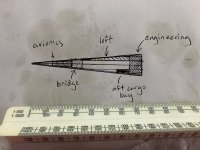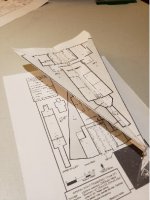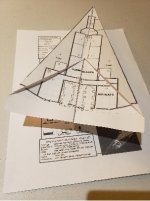Canon has starships massing 10 tons per Td
Note that 10,000kg per 14m
3 is a density of
lower than water (which would be 14,000kg per 14m
3).
"Steel is cheap and air is free" being an old axiom of (wet) navy ship building.
Most of the weight is carried by the rear skids, so figure about 500 tons on each 9m^2 skid.
You're ignoring the front skid.
Let's say for the sake of illustration purposes, that the skids are all 3m x 3m contact patches (2x2 deck squares) ... and there's 3 of them.
That's 27m
2 of contact patch(es) with the ground.
1,000,000kg (100 dTons) / 27m
2 = 37,037kg per m
2 ground pressure
Now, let's change the dimensions of those landing gear skids and see what happens.

Let's say for the sake of illustration purposes, that the skids are all 4.5m x 4.5m contact patches (3x3 deck squares) ... and there's 3 of them.
That's 60.75m
2 of contact patch(es) with the ground.
1,000,000kg (100 dTons) / 60.75m
2 = 16,491kg per m
2 ground pressure
So better, but still pretty high for austere unprepared field conditions when needing to land in the wilderness.

So let's change our assumptions again.
Let's assume that the landing gear IS NOT just a single plate that gets pushed down out of the hull at the ground (3m x 3m hole in the hull means a 3m x 3m contact patch on the terrain). Let's do a little bit of engineering and have the landing gear "unfold like a box" when it gets extended. Basically think of a D6 cube that unfolds the 4 sides after exiting the hull so as to flatten against the terrain surface in a cruciform cross of 5 contact patches (fore, aft, port, starboard plus center)
For simplicity, let's assume that the landing gear extends down out of a 3m x 3m hole in the hull on beefy self shortening oleo shock struts with actuators unfolding the "sides of the box" for each landing skid so as to normalize and spread the ground pressure more efficiently/effectively when setting down on unprepared ground.
Let's say for the sake of illustration purposes, that the skids all extend through 3m x 3m doors in the dorsal outer bulkead skin of the ship (2x2 deck squares) ... and there's still 3 skids ... but each of those skids "unfold" into an array of five 3m x 3m contact patches in a cruciform array for each landing skid. All liftoffs from and landings onto terrain are intended to be VTOL, so no need for wheels to make rolling CTOL maneuvers (no aerodynamic lifting body action going on with the hull shape either, so zero horizontal velocity VTOL landings it is).
That "folding" landing gear now adds up to 9m
2 * 5 * 3 = 135m
2
1,000,000kg (100 dTons) / 135m
2 = 7407kg per m
2 ground pressure
If I'm doing my math right

... the average human in flat shoes (standing still, on both feet) has a
ground pressure of
~17,000kg per m2 ... because 1 kPa (1000 pascals of pressure) equals 1000kg/m
2. The average walking human would double that ground pressure up to
~34,000kg per m2, which you'll notice is suspiciously close to my first calculation for a triplet of 3m x 3m contact patches (27m
2 in total) yielding a ground pressure of
37,037kg per m2.
In other words, even the minimalist option of using only 12 deck squares (3 sets of 2x2) for landing gear, with no folding articulations involved, is good enough to land on ground that is firm enough for a human to walk on. Add fold out articulated segments to those landing gear pads controlled by actuators to help spread out the load and you can quickly bring that ground pressure down below that of a human foot.
So now let's say that the cruciform folding landing gear is the way to go, but the fold out extensions only reach 1.5m away from the central 3m x 3m square contact patch of the main skid in the center. So now you've got 4 leaves of contact plates that are 1.5m x 3. which unfold in all 4 directions around the primary skid and landing strut.
1.5 * 3 * 4 + 3 * 3 = 27m
2 per landing leg * 3 legs = 81m
2 of contact patches with the ground
1,000,000kg (100 dTons) / 81m
2 = 12,346kg per m
2 ground pressure
By my calculations, that
12,346kg per m2 ground pressure would be LOWER THAN the
13,800kg per m2 reported as the
ground pressure for wheeled ATVs on Wikipedia ... which I figure ought to be "good enough for exploratory work" under most IISS circumstances if a Scout/Courier needs to "park" somewhere under gravity conditions on a world surface. The extra bits of articulation around each landing strut will also have the added benefit of acting like "toes" surrounding the "heel" of the main landing strut column helping to stabilize the ship when making contact with the ground during VTOL maneuvers. The outer "leaves" of the articulated landing gear could be angled downwards slightly past "flat" with the main central skid for a kind of "landing claw" position to help absorb the initial contact and "feel the ground" below before putting the full weight of the starship onto the main contact patches at the center of each landing strut.
Needless to say, I think this style of "folding landing claws" makes the most sense, both from a design aesthetic and from a practical engineering viewpoint.
Or it could all just be repulsor lift grav plated magic boogaloo ...





